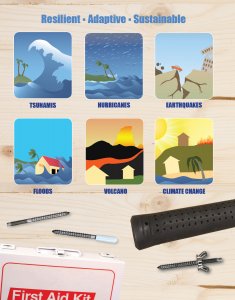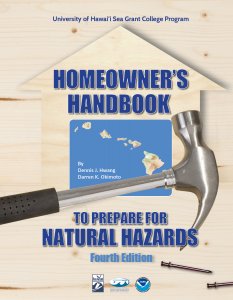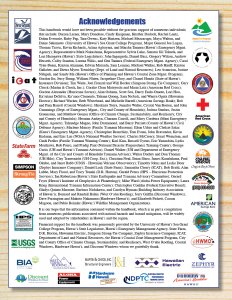What’s New in 4.0
Evacuation Planning – New resources, summarized in Tables can help families create their emergency and evacuation plans. Table 3-5 summarizes this Part of the book and provides interactive links for: (i) tsunami evacuation maps important for tsunami evacuation planning; and (ii) flood, storm surge and wind topographic speed up maps, important for hurricane evacuation planning. The maps for hurricane evacuation planning should be used with the shelter in place table with instructions (Table 3-4). Note for most evacuation scenarios, wait for specific instructions from emergency management or civil defense before evacuating as there will be warning time. The exception is when there is no warning time (e.g., a local tsunami (Table 3-3 Evacuation NOW Signals), an earthquake (“Drop, Cover, and Hold”) or flash flood (“Turn Around, Don’t Drown”). It is important to know what to do in advance before an event so that you can properly act when instructed by emergency officials, or when there is an event with no warning time.
Retrofit Options – Almost every house in the state can be strengthened for hurricanes, the #1 hazard risk in the state. The Handbook covers many retrofit measures such as how to install the Hawaii Plantation Tie hurricane clip, adding window protection and strengthening roofs. In addition, new methods to complete the load path with structural screws for double-wall houses are in the book and also here. There are many other best practices for flooding, earthquakes, and wildfire.
For Single Wall Houses on “Tofu Blocks” – See: (i) 2009 Post and Pier Seismic Retrofits Report; (ii) Demonstration of Post and Pier Retrofit with New Connectors; and (iii) Post-Demonstration Project Evaluation and Assessment. To see the benefits of a post and pier retrofit, view a video on the lab tests for Post and Pier Retrofit here (NOTE that some of the links in this 2009 video are no longer active).
Volcanoes – With the record activity in 2018 in Hawaii County, sections on volcanoes are added with the USGS to explain the science, the risk from lava and VOG, and how to cope.
Climate Change – Sections on climate change are added to address heat, drought, wildfire, infectious disease, sea-level rise and erosion. Working with partners (NOAA, DLNR, and Hawaii Wildfire Management Organization), the science is explained, applicable hazard maps with interactive links provided, and methods to reduce risk are identified.
Resilience, Adaptation, and Sustainability – Resilience strengthening measures now have a climate change adaptation and environmental sustainability component. See Part 4 for windows, roofs, solar panels, landscaping and energy efficiency. Also Appendix B supplements.
Resources
Updated tsunami preparedness video (2025)
Hurricane Ida – Damage Typologies: Resilient Repair, Retrofit, Rebuild & Recode Version 1.0
Expert: Preparing your home for hurricane should happen well before cyclone nears
Hawaiian Electric’s free Emergency Preparedness Handbook – Available in English, Cantonese, Ilocano, Korean and Vietnamese.
Learn how to prepare your family for emergency situations and get tips on electrical and food safety.
Hawaiian Electric’s Emergency Checklist
Hawaiian Electric’s Emergency Preparedness Tips Video
Communication Strategy and Outreach Plan to Prepare the Community for Natural Hazards (submitted to the Legislature in 2020).
Informal chat with Homeowner’s in Manoa highlighting the 4th edition of the Homeowner’s Handbook with Dennis Hwang. See the latest retrofit measures and discussion after Hurricane Douglas missed O’ahu in 2020.
Tsunami video gives insight, answers on how to prepare (2024)
Fourth Edition Acknowledgements
This handbook would have not been possible without the gracious support of numerous individuals that include: Darren Lerner, Mary Donohue, Cindy Knapman, Heather Dudock, Rachel Lentz, Dolan Eversole, Ruby Pap, Tara Owens, Katy Hintzen, Michael Mezzacapo, Maya Walton, and Diane Sakamoto (University of Hawai‘i Sea Grant College Program); Major General Joe Logan, Thomas Travis, Kevin Richards, Arlina Agbayani, and Marsha Tamura (Hawai‘i Emergency Mgmt. Agency); Representative Mark Nakashima, Representative Sylvia Luke, Senator Jill Tokuda, and Lori Hasegawa (Hawai‘i State Legislature); John Ingargiola, Daniel Bass, Gregory Wilson, Andrew Herseth, Colby Stanton, Lorena Willis, and Gen Tamura (Federal Emergency Mgmt. Agency); Carol Tyau-Beam, Kristen Akamine, Edwin Matsuda, Sam Lemmo, Michael Walker, Rob Hauff, Kirsten Gallaher, and Dietra Myers Tremblay (Dept. of Land and Natural Resources); Leo Asuncion, Justine Nihipali, and Sandy Ma (Hawai‘i Office of Planning and Hawai‘i Coastal Zone Mgmt. Program); Gordon Ito, Jerry Bump, William Nhieu, Jacqueline Choy, and Chanel Honda (State of Hawai‘i Insurance Division); Tim Waite, Joel Frenzel and Will Becker (Simpson Strong-Tie Company); Gary Chock (Martin & Chock, Inc.); Coralie Chun Matayoshi and Maria Lutz (American Red Cross); Gordon Alexander (Hurricane Secure); Alan Oshima, Scott Seu, Darcy Endo-Omoto, Lori Hoo, Ka‘iulani DeSilva, Ka‘anoi Clemente, Tatiana Quong, Sam Nichols, and Wanya Ogata (Hawaiian Electric); Richard Wacker, Beth Whitehead, and Michelle Bartell (American Savings Bank); Bob and Pam Barrett (Coastal Windows); Hirokazu Toiya, Jennifer Walter, Crystal Van Beelen, and John Cummings (Dept. of Emergency Mgmt., City and County of Honolulu); Joshua Stanbro, Justin Gruenstein, and Matthew Gonser (Office of Climate Change, Sustainability, and Resiliency, City and County of Honolulu); Herman Andaya, Charnan Carroll, and Misty Cordeira (Maui Emergency Mgmt. Agency); Talmadge Magno, John Drummond, and Barry Perriatt (County of Hawai‘i Civil Defense Agency); Marlene Murray (Pacific Tsunami Museum); Elton Ushio and Chelsie Sakai (Kaua‘i Emergency Mgmt. Agency); Christopher Brenchley, Tom Evans, John Bravender, Kevin Kodama, and Eric Lau (NOAA National Weather Service); Charles McCreery, Stuart Weinstein, and Cindi Preller (Pacific Tsunami Warning Center); Karl Kim, Russell Uyeno, Eric Yamashita, Lydia Morikawa, Rob Porro, and Pradip Pant (National Disaster Preparedness Training Center); George Curtis (UH and Hawai‘i Tsunami Advisor); Daniel Walker (UH and Department of Emergency Mgmt. of the City and County of Honolulu Tsunami Advisor); Walter Dudley and Don Thomas (UH Hilo); Clay Trauernicht (UH Coop. Ext.); Christina Neal, Brian Shiro, James Kauahikaua, Paul Okubo, and Janet Babb (USGS – Hawaiian Volcano Observatory); Timothy Johns and Leslie Door (Zephyr Insurance Company); Daniel Losk (State Farm); Samantha Cherry (ICAT); Bob Bruhl, Alan Labbe, Mary Flood, and Tracy Tonaki (D.R. Horton); Gerald Peters (HPS – Hurricane Protection Services); Ian Robertson (Hawai‘i State Earthquake and Tsunami Advisory Committee); Gerard Fryer (Hawai‘i Institute of Geophysics & Planetology); Mike Ward (Aloha Power Equipment); Laura Kong (International Tsunami Information Center); Christopher Conklin (Federal Executive Board); Gladys Quinto Marrone, Barbara Nishikawa, and Carolyn Hyman (Building Industry Association of Hawai‘i); Bernard and Randall Balais (West O‘ahu Roofing); Jerry Griffin (Discount Windows); Dave Purrington and Makoto Nakamura (Hardware Hawai‘i); and Elizabeth Pickett, Carson Magoon, and Pablo Beimler (Hawai‘i Wildfire Management Organization).
It is our hope that the information contained within the handbook, which is in part a compilation from numerous publications associated with natural hazards and hazard mitigation, will be widely used and adopted by stakeholders in Hawai‘i and the region.
Financial support for the handbook was generously provided by the University of Hawai‘i Sea Grant College Program, Hawai‘i State Legislature, Hawai‘i Emergency Management Agency, State Farm, D.R. Horton, Hawaiian Electric, Simpson Strong-Tie Company, Zephyr Insurance Company, ICAT, Department of Land and Natural Resources, the Hawai‘i Coastal Zone Management Program, City and County Office of Climate Change, Sustainability, and Resiliency, West O‘ahu Roofing, Coastal Windows, Hardware Hawai‘i, and Discount Windows whom we gratefully thank.




